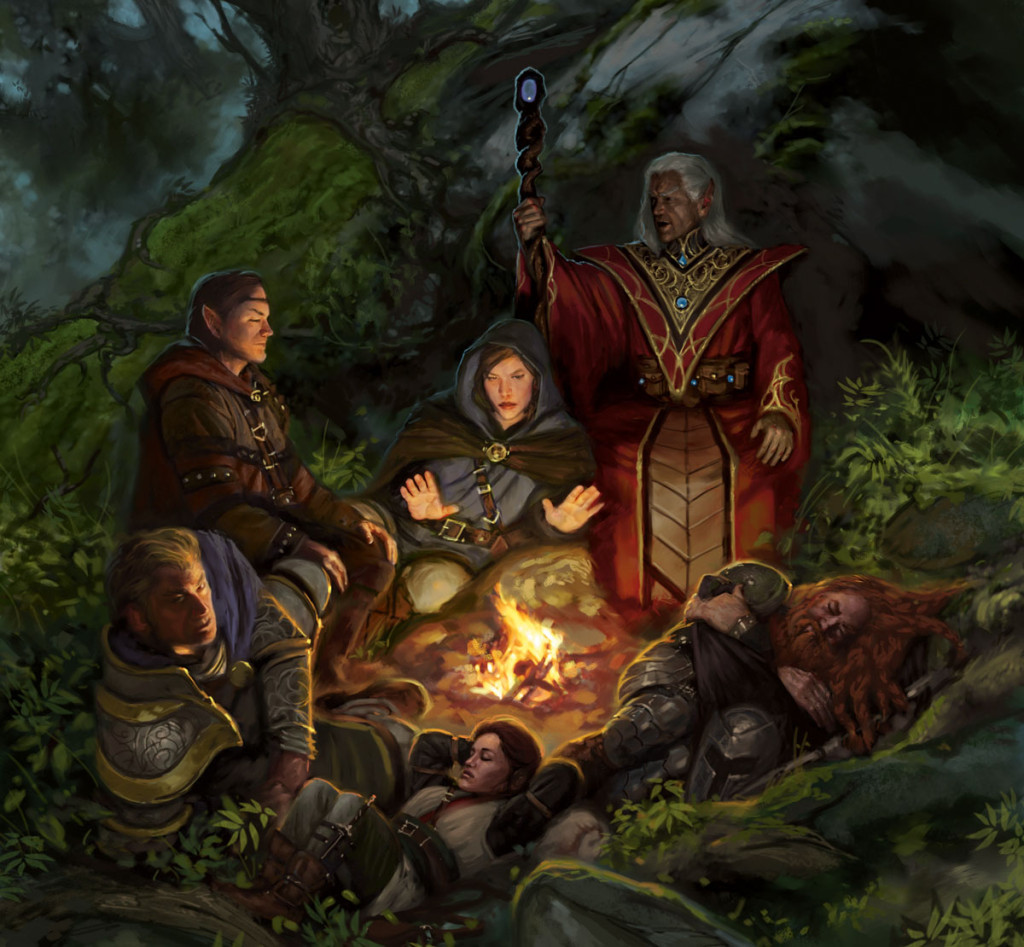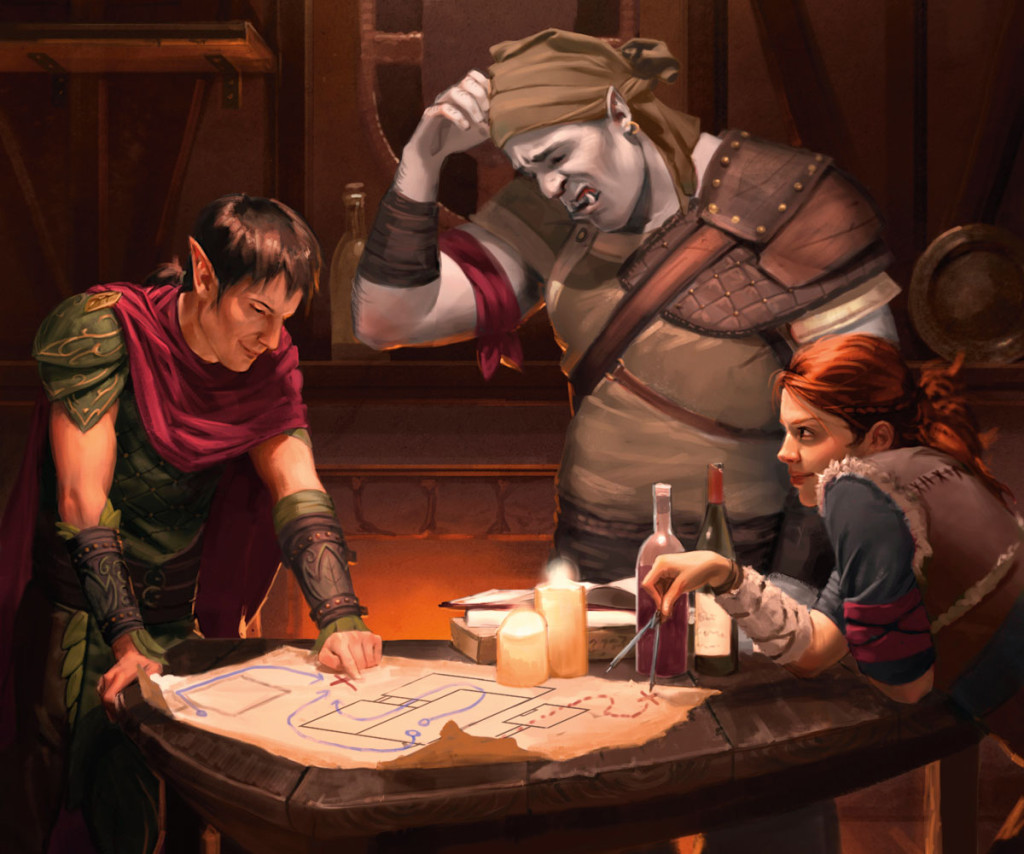
Action points and character powers are out. Attribute based saves and a Vancian magic system are in. Some see this as rewinding the clock on Dungeons and Dragons, largely undoing the changes made by fourth edition.
But the more I parse the player’s handbook, the less I agree with that interpretation. Beneath its mechanics, this edition feels more primeval. It hints at a heritage many gamers my age never experienced–one more wonderful and dangerous than I can really explain. I haven’t been this excited for the game in over a decade.
Changes
It’s reasonable to compare the fifth edition of Dungeons and Dragons to D&D 3.5 and Pathfinder. Barbarians are back to raging, then wading in. No need print out a deck of cards to track your options; you are a freight train of muscle, now go smash things. Wizards have low-damage at-will cantrips, but must say goodbye to powerful spells they get back every fight. Spell slots have returned (though most casters pick a set number of spells, then cast any combination of them given a number of spell slots per day). No more of that constant magic missile business. And these are real spells, like protection from energy, Melf’s acid arrow, and wish. That last one made me sigh contentedly. Classes are back to having lists of spells they largely share instead of only having unique, exclusive powers. Every character has a proficiency bonus they add to anything their character is generally good at (attacks, skills they are trained in, saves that fit their class) along with an attribute bonus, and that’s usually all the math you have to do for checks.
Traces of 4e remain visible. Some classes regain abilities after short rests (though such rests now take an hour of game time), and characters have hit dice they can spend to regain HP, rather than relying solely on a healer. Many spells can be prepared normally and cast in one action, but some, like alter self, can be cast as rituals. This takes at least ten minutes, but in this case spells don’t have to be prepared ahead of time.
So it’s fair to say the game borrows its previous two editions, and the result seems to be a trim system with faster combat. Small combats are worth having, because they’re quick and still drain resources from characters. That sounds great. Overall, the game has a modern sheen, emphasized by the fact that you can play it right now for free, since the basic rules for DMs and players are available in PDF form for anyone.
But that’s all vitamins; bring on the cake. For me, D&D has never really been about mechanics or character builds or succeeding a tumble check to gain flanking. No. What matters is how it feels when the dragon is dead and you shovel mountains of gold into your bag of holding. The palpable silence when you realize that you’ve done something the DM wouldn’t have expected in a million years, and the elation you feel when it works. The slow, awful realization that the soul you’ve been inhabiting for the last 6 months is dead, a hundred miles underground.
The feeling that you can do anything. That anything could happen. A simulation of infinite fidelity, where you forget about the rules and the game feels real. That spark is visible in the new version of Dungeons and Dragons, and I believe it comes from an age older than most people are giving it credit for.
To me, this version screams Advanced Dungeons and Dragons, 2nd edition.
New old school
For one, the new edition’s official stat generation method is to roll dice, then assign them how you want. The book says you can assign them from an array, but point buy is considered a “variant,” and you can only buy a stat up to 15 (and stats normally cap at 20). Player characters are required to have backgrounds and, more importantly, flaws (“I speak without really thinking through my words, invariably insulting others”). It’s easy to see how poorly rolled stats could align perfectly with these.
The AD&D handbook features a sizable explanation on why rolling poor stats makes the game more fun. It pushes you towards playing characters that are horrendously flawed, instead of blank, uninteresting virtue slates. Without that push, many players would prefer to just play someone eminently heroic and capable, but they’re missing out. Even better, when a character with bad stats dies (which was pretty possible in AD&D), there’s a lessened sense of responsibility–it doesn’t feel like losing. This put an emphasis on the fact that you can’t win the game because it isn’t beatable; all that matters is having a good time.
Reincarnate is back as a spell, complete with a table to randomly determine which race a character comes back as (sadly, badger is not on the table, but I feel a house rule incoming). Wild magic surges include effects like “Your skin turns a vibrant shade of blue,” or “You grow a long beard of feathers that remains until you sneeze…” AD&D oozes that kind of random magical nonsense, and was better for it, because that’s the sort of thing you remember years later. I can’t wait to see what they do with the Rod of Wonder.
Feats are not a mandatory part of character progression in the new version (in fact, they’re a variant rule, to be used at the DM’s discretion). While they can be taken as an extra game feature, players must sacrifice ability progression to do so. Even then, they are just as likely to be things like “actor” or “keen mind” (you always know which way is north, you know the number of hours before sunrise or sunfall, and you can recall anything you have seen or heard in the past month). There are the usual weapon/armor proficiency feats and some that change combat in substantial ways, but most are themed in interesting ways. More importantly, tons are aimed almost purely at roleplaying and emphasizing what sort of person your character is.
Players are no longer durable. Ogres have a challenge rating of 2, meaning it is not impossible for level 1 players to fight them (though the game says to be careful about this at low levels); at level 2, they should be a fair fight. A wizard begins their life with 6 + Con hit points. So let’s say 7. An ogre’s club does 2d8+4 damage, easily enough to kill said wizard outright in a single smash. Even at level 2, that wizard would have 12 health, still placing them very close to instant death, given a solid blow. “Save or die” spells are still missing, but this edition makes characters much more fragile, especially at early levels. AD&D is infamous for its treatment of PCs; while the new version doesn’t go quite so far, it is far less kind than 4e.
And battle grids are optional. With flanking out (rogues just need to have someone else in mele range of their target), it makes sense. Whether they like the term “theater of the mind” or not, you can hear DMs sighing contentedly.
Less is more
Pathfinder, 3.5, and 4e are all committed to giving players choices when they progress. 4e took this to a new level by adding significant power choices for any player at any time, and encouraging players to create wishlists of what magic items they wanted (emphasized by the fact that magic items were originally listed in the player’s handbook, not the DM guide). When players level up, they almost always get to make choices.
In the new version, that’s almost all out the door. Classes specialize around level 2 or 3 (wizards choose a school, druids choose a circle, monks choose which tradition they follow), but aside from this players usually only directly change their character every four levels or so, when they either increase their attributes or choose a feat. Many players will have a problem with this in theory; in practice, it takes the focus away from what your character is made of and towards who they are and what they’re doing. 4e made the mistake of codifying ways players could affect the world instead of just staying flexible, then leaving it up to the DM. When every class has 20 pages of character options, the game’s focus becomes deciding which of those a player should get. When players feel entitled to specific magic items, they get antsy if they don’t drop.
A lot of this falls to advantage and disadvantage. When a character has an advantage on any attack or check, they roll two d20s and take the higher result. Disadvantage is the opposite, so you take the lower roll. Statistically, this is either adding or subtracting 3.3 to a die roll; in effect, it feels huge and gives DMs a means to improvise in a way that makes sense. Shooting arrows out of a moving carriage in the rain? Disadvantage. Trying to pick the pockets of a noble whom your bard friend is distracting with a ballad? Advantage. No weird modifiers. Move it along.
Also interesting is the idea of inspiration. Your character either has inspiration or they don’t (it doesn’t stack), and when you use it you gain advantage on a roll. A DM can award inspiration to a player who they think roleplays their character well–particularly when they act in a contrary to their interests, but that accurately reflects their flaws. Even better, a player can give their inspiration to another character as a reward for roleplay they think is particularly awesome. Mechanically, time will tell how these things play out, but as rules they absolutely support the game’s ideals.

Character progression in 4e (and 3.5/Pathfinder to a lesser extent) often came down to deciding what was optimal. But think about your favorite characters from fiction. Chances are they had to overcome some pretty severe disadvantages or flaws; some of them are probably permanently damaged. Building optimal characters works for video games when it’s one player versus an AI in a test of skill. For cooperative tabletop RPGs, being unique is important, but feeling unique is what really matters. It’s about feeling like you’re six again, with the rules only there to propel you forward (and disguise the fact that you’re just having a bit of make-believe). Remember when your friends would say “Nah uh, I’m bulletproof”? Remember how that was obnoxious? That’s basically all interrupt actions, or at least how it feels to the DM.
Given a system that can react to players, the illusion is inevitable. Even if 4e had a balanced combat system (it didn’t, in my opinion), meaningful encounters needed to be complicated. As players gained more and more abilities, the thoughtfulness needed to challenge them increased logarithmically. This meant spending tons of time creating encounters. In the best case, DMs could create extra encounters to swap in if players went off the beaten path. In the worst case, DMs could force players to have encounters, because with how much time I spent , you’re not going to talk your way out of a fight, dammit.
Between design slimming and clear monster design (seriously, the stat blocks even look like they did in ADND), I honestly think most of these problems have been solved. Tabletop roleplaying isn’t just about mechanics, and if the stories first time DMs are telling are any indication, new D&D knows it. This edition won’t be perfect, because that’s not possible.
But if it captures even an ounce of the old magic, you owe it to yourself to try it out. I can’t wait.
Leave a Reply